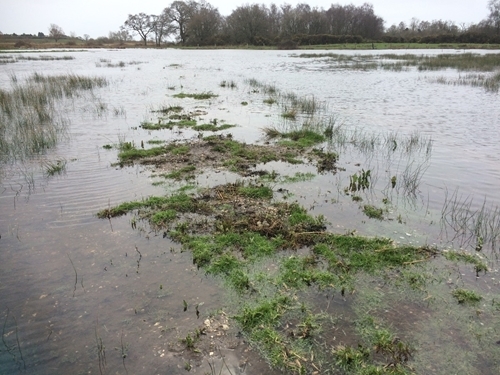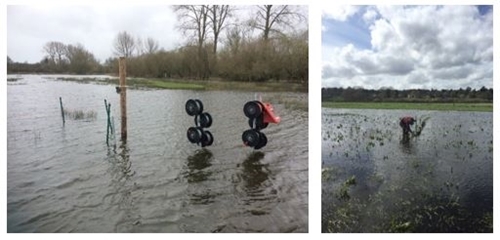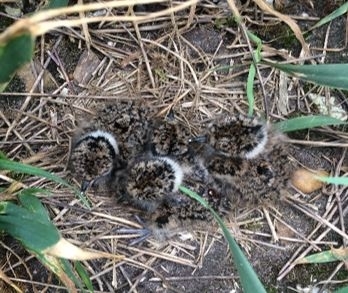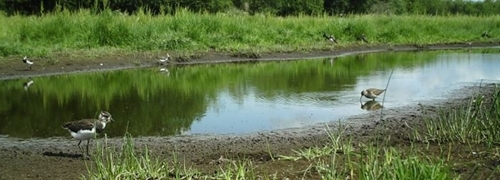
By Ryan Burrell, Life+ Waders For Real Project Ecologist
With temperatures warming and the days getting longer, breeding Lapwing will shortly be back in the Avon Valley. We have been a busy team this winter, establishing 2 new breeding wader hotspot sites and monitoring wintering waterfowl and waders. So, before we get into the 2019 season, we thought it would make sense to reflect on 2018.
The 2018 early spring weather conditions were challenging for the breeding waders in the Avon Valley. In early March with male Lapwing already starting to display, we were faced with the beast from the east and heavy snow fall. Lapwing retreated to the coast large numbers observed locally but also turned up in some rather odd places, like the GWCT carpark. Lapwing was not a species we ever expected to see from our office window. Then in late March/early April we had heavy rain and flooding, which flooded out early nests and limited options for subsequent breeding attempts.

Figure 1: One lapwing nest that narrowly missed being flooded
However, the resulting late spring habitat conditions for breeding waders were favourable, with the high availability of wet habitats being ideal for chick foraging. Though our team strived to cause as little disturbance to the birds as possible in an already testing year, we know lapwing pair numbers remained at 73 pairs on water meadow sites, the figure reached over the Waders for Real project. Lapwing productivity reached just over 0.7 chicks fledged per pair, which is the value required to maintain a stable population. Though, this figure is based on the sites that we were able to monitor effectively and is most likely represents a minimum value. Improving productivity is a key part of our project, achieved through increased density of wet features and predator exclusion fencing.
The early spring weather also meant that these electric fences were severely affected. We install fences early in the season in locations based on previous years’ nesting and chick foraging sites and around some of our new habitat features, with the purpose of excluding mammalian predators to lower predation rates of both nests and chicks. As these areas are naturally low lying, maintaining wetness throughout the breeding season, it meant that they were some of the first areas to flood. This increased the amount of time we had to spend on fence maintenance (regular checking which involved clearing flooding debris from the wires, righting fallen poles, testing the circuit etc.) to make sure they were effective in time for when the waters finally retreated. Investigating the effectiveness of this method on working wet pastural farmland and feeding this into stewardship policy is a key part of Waders for Real. A further update on our predator exclusion work will feature in a blog next month so stay tuned.

Figure 2: Electric fences during the flooding – right picture shows clearing of flooding debris from wires. Unexpected flooding possessing an on-going issue for this technique.
Also in 2018, we conducted the periodic 7-year census of water meadows throughout the Avon Valley up to Salisbury. This census formed the basis of our project, providing the data which demonstrated the decline in breeding waders and convinced the EU to grant our project funding. Unfortunately, no breeding lapwing were found north of water meadows at Burgate, though this exercise did produce new information on arable breeders in the north of the valley. As a result, we have in 2019 established a new water meadow hotspot just south of Salisbury. With intensive habitat management it is hoped Lapwing from neighbouring farmland will soon colonise this site.

Figure 3: Lapwing chicks still within their nest on one of the arable fields adjacent to the hotspot site
Coincidently, we wish to gain a better understanding of how our population interacts with adjacent farmland. So, 2018 we focused on areas adjacent to our hotspot sites. 7 birds previously ringed as chicks on the water meadows were found breeding on adjacent arable fields (identified by their colour-rings). Some fields held important numbers of lapwing, for example 10 nests were being monitored on one 9ha field by our team at one point in the season. Lapwing nests were marked, and broods avoided by our devoted farmers. Undertaking this research in 2019, will help us to better understand our recruitment of returning juvenile lapwing and the reasons behind breeding site choice, whether for example these colour-marked birds return to the water meadows.
In general, the field season was busy for everyone in the team as per usual. In addition to the main monitoring work carried out on the breeding waders (wader surveys, nest finding/monitoring and chick monitoring), various members of the team were out conducting surveys and monitoring a variety of species and habitats across our water meadow sites. These included vegetation surveys, dragonfly surveys along ditch and river transects, aquatic invertebrate sampling from the ditches and river, terrestrial invertebrate sampling (to look at chick food abundance), regular bird surveys at all the sites, and camera traps being run at the hotspot sites (to look primarily at mammalian predators). Through Waders for Real we hope to gain a better understanding of management for breeding waders can benefit the whole ecosystem alongside remaining profitable for farming.
Our work GPS tracking foxes continued in 2018, with an update provided during the field season by our Mammal Ecologist – W4R Blog - Tracking foxes in the Avon Valley: An update
Fox diet research continued throughout 2018, with Jodie Case collecting scats throughout the valley (W4R Blog - Fox diet research in the Avon Valley). These have now been sent to Sweden for DNA-analysis. This should improve our understanding of how foxes are sustaining themselves in the valley, shed light on how related our population is, provide another measure of fox density, and reveal how effective fox scat searches are at detecting resident foxes.
It won’t be long now before the lapwings start to think about breeding for this year, and the field season will start all over again. Hopefully this coming breeding season will prove to be yet another good year for breeding waders in the Avon valley! Stay tuned!

Figure 4: Lapwing and redshank broods using one of the wet features we created for foraging
Want to learn more about Waders For Real?
Visit the Waders For Real website and get all the latest project updates on Twitter and Facebook.